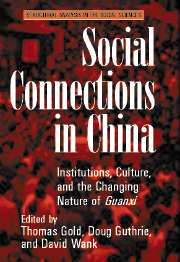Book contents
- Frontmatter
- Contents
- Contributors
- List of Figures and Tables
- Prologue
- Introduction
- Methodological and Conceptual Considerations
- 2 Information Asymmetries and the Problem of Perception: The Significance of Structural Position in Assessing the Importance of Guanxi in China
- 3 Beyond Dyadic Social Exchange: Guanxi and Third-Party Effects
- New Substantive Studies of Guanxi
- Conclusions
- References
- Index
2 - Information Asymmetries and the Problem of Perception: The Significance of Structural Position in Assessing the Importance of Guanxi in China
Published online by Cambridge University Press: 30 July 2009
- Frontmatter
- Contents
- Contributors
- List of Figures and Tables
- Prologue
- Introduction
- Methodological and Conceptual Considerations
- 2 Information Asymmetries and the Problem of Perception: The Significance of Structural Position in Assessing the Importance of Guanxi in China
- 3 Beyond Dyadic Social Exchange: Guanxi and Third-Party Effects
- New Substantive Studies of Guanxi
- Conclusions
- References
- Index
Summary
In earlier work, I have taken the position that the importance of guanxi in China's transitional economy depends on the institutional environment in which economic and social action are embedded (Guthrie 1998a, 1999). I have also argued that there is nothing fundamentally Chinese about the concept of guanxi, as it is dependent on the structure of distributions systems, the structure of opportunities in the market, and the formality and stability of market institutions themselves. In weak institutional environments, where the formal rules of economic interaction are vague or non-existent, where economic and social structures are built on particularistic relationships, it is not surprising to find that guanxi carries the day. Such was the type of structure and rules that constituted Chinese society at the dawn of the economic reforms. However, these economic reforms in China have unleashed fundamental changes on the structure, rules, and norms of the economy in China, and as the institutional structure of society has changed in China, so have the rules and practices of the market and economy. This natural experiment has, in my view, been the best test of the guanxi question: As institutional and economic structure change, what is the fate of guanxi in the midst of these changes? Does guanxi remain a fundamental part of economic and social action even in the face of major institutional change? Does it become less important as formal structures become more routinized? In either case, what do the changes (or lack thereof) tell us about the nature of connections in Chinese society?
- Type
- Chapter
- Information
- Social Connections in ChinaInstitutions, Culture, and the Changing Nature of Guanxi, pp. 37 - 56Publisher: Cambridge University PressPrint publication year: 2002
- 43
- Cited by



